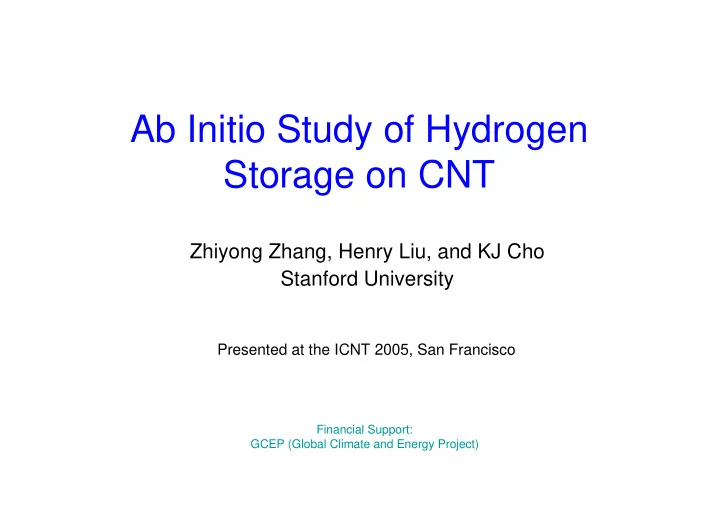

Ab Initio Study of Hydrogen Storage on CNT Zhiyong Zhang, Henry Liu, and KJ Cho Stanford University Presented at the ICNT 2005, San Francisco Financial Support: GCEP (Global Climate and Energy Project)
Rational Design of Hydrogen Storage Material • High Storage Capacity: 6.5 wt%, 65 g/L • Desorption Temperature: 60~120 °C • Thermodynamically slightly stable hydrogen storage systems are desired and can be achieved through material engineering. • Reversibility dilemma: Reversibility is usually associated with high- energy barrier for dissociation and adsorption. • Solution: Engineered catalyst can tune the energy barrier.
Multiscale Design of Nanomaterials for Hydrogen Storage Chemisorption: H 2 + NM NM-2H - H-H bond breaking = 4.5 eV poor reversibility (too strong bonding) + high surface coverage ? stability of NM-2H states Physisorption: H 2 + NM NM-H 2 + weak adsorption good reversibility - small surface coverage (much less than a few wt. %) Controlled Catalytic Chemisorption + high surface coverage & good reversibility
Experimental results • Dillon et al., Nature, 386 , 377 (1997) – Room temperature, 300 torr, soot with 0.1 wt% SWNT – 0.01 wt% hydrogen adsorption, equivalent to 5~10 wt% on pure SWNT. • Ye et al., Appl. Phys. Lett. 74 , 2307 (1997) – 80K, 100 bars, pure sample . – 8.25 wt% hydrogen adsorption. • Liu et al., Science 286 , 1127 (1999) – Room temperature, 100 MPa, pure sample. – 4.2 wt% hydrogen adsorption. • Chen et al., Science 285 , 91 (1999) – Ambient pressure, Li or K doped carbon nanotubes . – 14 ~ 20 wt% hydrogen adsorption. FTIR show that H 2 is dissociative. Other experiment suggests it is due to water adsorption. – Only 0.4 wt% hydrogen adsorption without doping. • Nu¨tzenadel et al., Electrochem. Solid-State Lett. 2 , 30 (1999) – 0.39 wt%, electrochemical hydrogen storage.
Controlled Hydrogen Bonding on Carbon Nanotubes H stability of chemisorbed hydrogen (NM-2H) states relative to H 2 gas can be Stable adsorption tuned by nanotube size: (8,0) - (12,0) CNTs would have enough binding energy (up to 0.5 eV) per H 2 molecule Prediction (solid curves) Ab-initio results ( and ) S. Park, D. Srivastava, and K. Cho, "Local reactivity of fullerenes and nano-device applications," Nanotechnology 12, 245 (2001).
Optimal Configurations of Adsorbed Hydrogen Pairs C3 LDA , US LDA , PAW GGA , US GGA, PAW C1C2: 0.263 eV 0.291 eV 0.142 eV 0.222 eV C4 C1C3: 0.018 eV 0.046 eV -0.374 eV -0.264 eV C1 C1C4: -0.045 eV -0.017 eV -0.403 eV -0.306 eV C5 C1C5: -0.317 eV -0.289 eV -0.483 eV -0.402 eV C2 Projected LDOS H C1 C4 C3 C5 C2
Optimal Configurations of Adsorbed Hydrogen Pairs 2 nd pairs: 0.709 eV 3 rd pairs: 1.281 eV 4 th pairs: 2.138 eV
Coverage Dependence of Binding Energy •The maximum chemi-sorption capacity is around 50% or less •Binding is very strong at low coverage.
Coverage Dependence of Binding Energy Binding Energy vs. Coverage, Most Probable Coverage Pattern 1.0 Binding Energy per Hydorgen Molecule 0.0 0 0.2 0.4 0.6 0.8 1 H 2 (eV) -1.0 -2.0 -3.0 Coverage Avearge Incremental Incremental, GGA, PAW results •The maximum coverage is around 75% with external binding. •The binding energies are in a narrow range of 0.4 eV ~ 0.6 eV (0.12 ~ 0.22 for GGA and PAW)
Absorption of Atomic Hydrogen on SWCNT o C C1s XPS C1s XPS (1) T=40 o C (2) T=200 o C (3) T=300 Intensity (arb. units) Intensity (arb. units) o C (4) T=400 o C (5) T=470 o C (6) T=580 o C (7) T=750 (7) (6) (5) (4) (3) (2) (1) 288eV 286 284 282 288eV 286 284 282 Binding energy (eV) Binding energy (eV) •Atomic source of H for hydrogenation. •Diameter of SWCNT in the range of 1nm to 1,8 nm. •65±15% (5.1±1.2wt%) of hydrogenation. •Stable in the temperature range of 300~600°C.
Experimental results, Dissociative H 2 Adsorption Carbon Nanotube Sorption Science External Peer Review of NREL Activities, January 19-23, 2004 •No hydrogen storage was observed in pure single-walled carbon nanotubes. •Roughly 3 wt.% was measured in metal-doped nanotubes at room temperature.
H2 Dissociation on CNT C1 C6 C2 H2 Dissociative Adsorption on CNT C5 C3 3 C4 2.5 2 Energy (eV) 1.5 1 0.5 0 -0.5 Reaction Coordinate C7 C1C4 C2C3 C1C2 1.6 3 1.4 2.5 1.2 2 1 1.5 0.8 1 0.6 0.4 0.5 0.2 0 0 -0.5 0 2 4 6 8 10 -0.2 0 2 4 6 8 10 -1 -0.4 -1.5 -0.6 C1C4 C2C3+C1C4 C4C7+C2C3 C2C3
H2 Dissociation on N-Doped CNT C1 C2 1.500 C6 1.000 C5 C3 0.500 N 0.000 0 2 4 6 8 10 12 14 -0.500 C7 C5C8/Doped CNT, Physisorption C1C4 Pure CNT C5C8/Doped CNT C8
H Diffusion CNT C1 3.5 3 C6 2.5 C2 2 1.5 1 C5 C3 C4 0.5 0 -0.5 0 2 4 6 8 10 12 14 -1 C1C4 to C2C3 C1 to C2 then C4 to C3 C7 C1/C1, C4 to C3 C3/C3, C6 to C2 80+C2toC3
Conclusion • The hydrogen biding energy strongly depends on the coverage on the CNT. Computational results indicate that the binding energies fall within a narrow range of energy in the most likely coverage pattern. • We have identified the most likely dissociative adsorption pathway and studied the diffusion pathway of hydrogen on CNT. • Computational results indicate that doping the CNT can substantially lower the dissociative adsorption pathway and thus improve the hydrogen storage kinetics.
Recommend
More recommend